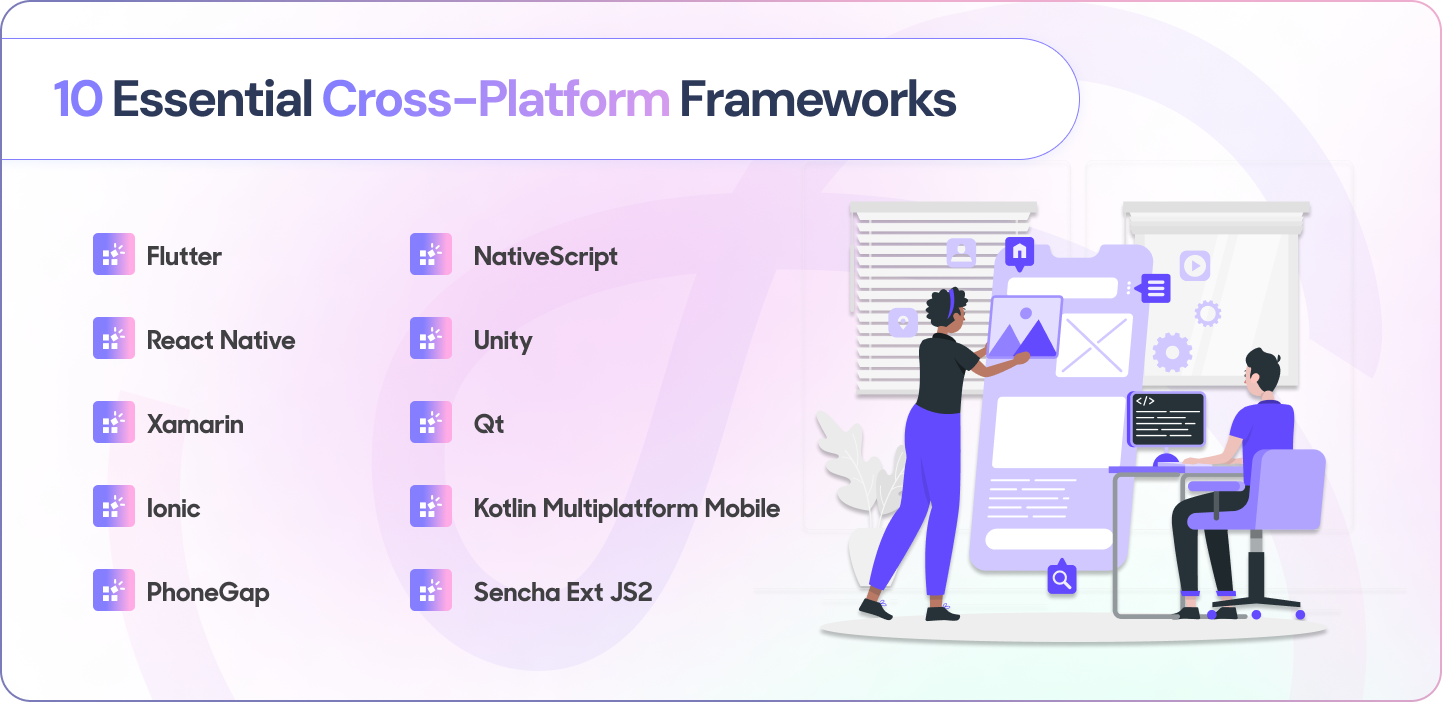Why these 10 Cross-Platform Frameworks Are Essential for Developers in 2025
Mobile application development has still been an important aspect of business strategies in dealing with enterprises across the globe in the present times of swift technological change. App demand across the different sectors is enhancing and thus there is a need for businesses to find ways in which high quality applications which can work on various platforms can be developed in a short period of time and at low costs. Hence, this is how cross-platform frameworks have been disruptive technologies for mobile app developing companies. Moving forward to 2025, such frameworks are going to be more crucial than ever to the developers and mobile app development firms.

Top 10 mobile development cross-platform frameworks have gathered some audience and we will discuss their relevance in comfort out of the house.
1. Flutter
Flutter, owned by Google, rapidly gained the popularity among developers and became one of the most well known cross platform examples ever. In a single code’s vane apps for iOS, Android and web can all be created. As for the biggest benefit of the framework , it is the performance. It is close to the Native performance level because there is no intermediary in the code translation process as it is done in other frameworks.
Mobile app development companies will still favor Flutter by 2025 due to its rapidly developing market and many users’ support. Flutter is important in the future of cross-platform app development because of the availability of a variety of prebuilt widgets, integration with Firebase and continuous support from Google.
2. React Native
Facebook’s React Native has been the leading technology in cross-platform development since its inception. Developers are able to code in JavaScript and React and then deploy the application for iOS as well as for the Android operating system. The advantages come to the developers,since about 90 % of the codes can be reused with other mobile applications regardless of the platform.
It can be predicted that in 2025, React Native will still remain one of the key frameworks for those developers who highly appreciate their efficiency, performance and large community. Mobile applications development Studios intending to cut down expenses on the development of applications for different platforms will also rely on React Native.
3. Xamarin
Documentation regarding Xamarin. This tool enables cross-platform development and is the cross-platform development tool made by Microsoft. With the help of C#, mobile app developers can create applications compatible with iOS, Android as well as Windows all at one go with a unified code base. Structurally, Xamarin is unique since it has full access to native APIs and toolkits hence allowing developers to enhance their applications with platform oriented functionalities without altering the cross platform code structure.
Regardless of how other technologies will develop, by the year 2025, for mobile app development companies focusing on many platforms without compromising on native performance, Xamarin will still be in use.
4. Ionic
Ionic is a mobile application development framework which is a hybrid one which allows the mobile application developers to create mobile applications using the web technologies like HTML, CSS and Javascript. It is a common choice for app developers because of its integration with Angular and React and also the available ready-made components in the framework for the simple design.
And in 2025 no app developer company will ignore Ionic since there will be a high demand in the construction of apps for different operating systems including iOS, Android and the web, but within only one codebase. The fact that it is open source and very flexible will make it stay relevant.
5. PhoneGap / Cordova Apache Cordova (Previously PhoneGap)
It is user-friendly and allows developers to create mobile applications with the help of standard web technologies like HTML5, CSS82 and JavaScript. The application is packed within a native wrapper and hence does not require the use of native development to access device APIs, which is a limitation of using web technologies. Even though Cordova could stand the test of time against tougher competition from newer frameworks, in 2025, Cordova will still be in existence as a tool of choice for mobile application developers who use web technologies. Its long life span and extensive support from the community will continue to facilitate that it be used for some kinds of applications.
6. NativeScript
NativeScript is an open source framework that allows developers to build iOS and Android apps utilizing JavaScript or angular TypeScript. It’s a mature framework performing something in the middle, which provides all the inbuilt advantages cross-platform development brings and outperforms in performance by permitting native API calls. 2025 NexusN inapp which maintaining the web structure for mobile app development companies wanting to provide a native like efficiency will prove to be crucial.
7. Unity
Unity is often related to game development. Nevertheless, it have come to be looked at as a cross platform framework in the mobile application development for any other industry. Unity allows developers to create high end 3D as well as 2D applications for mobile, desktops and even AR/VR along with the ability to produce applications which are cross platform.
8. Qt
Qt is a versatile application framework designed to create desktop and mobile applications. Built on C++, Qt allows fast and scalable application development with cross platform capabilities with little or no source code changes.
Mobile applications developers in sectors which are time-critical and performance-centric such as automobile or medical engineering will appreciate the use of Qt in 2025. Its practicality and a broad array of supported operating systems will cement its position to the trend of mobile app development.
9. Kotlin Multiplatform Mobile (KMM)
Being on the chart of the most adopted languages for native Android development, Kotlin has placed KMM which is Kotlin Multiplatform Mobile under Google. KMM solves the issue of having to code separately for two different platforms by incorporating shared code architecture between the two apps.
Kotlin will certainly gain more recognition by 2025, and as a KMM mobile app development company, KMM will help develop useful and better mobile applications which are native while using fewer redundant codes.
10. Sencha Ext JS2
Sencha Ext JS can be defined as a JavaScript application framework in which high performance UI components help create cross platform applications. Those who develop mobile applications use Sencha for developing complex web applications that can easily transform into mobile apps.
The year 2025, the mobile apps will be more data-oriented especially for enterprise-grade apps forcing mobile app development companies to continue loving for Sencha Ext JS owing to the vast tools available for usage and the simple incorporation of Sencha Ext JS into existing workflows.
Conclusion
Even as the exponential growth in demand for mobile apps continues, better ways of creating cross platform apps will determine how mobile app developers as well as mobile application development companies will be in the year 2025 and beyond. It is thus understandable why these frameworks each has its features that serve unique business and development needs yet aim at speeding up development time, reducing development costs and complexity.
Today, developers need such cross platform frameworks in enhancing their competitiveness in a very competitive market as well as preserving their skill set for the future as mobile app development continues to change. For most businesses working with a mobile app development company that has expertise in such technologies will guarantee them a solid, well-performing application across all the targeted platforms.
It is obvious that mobile app development is moving towards the cross-platform development strategy, and such frameworks will be at the center of this development.


